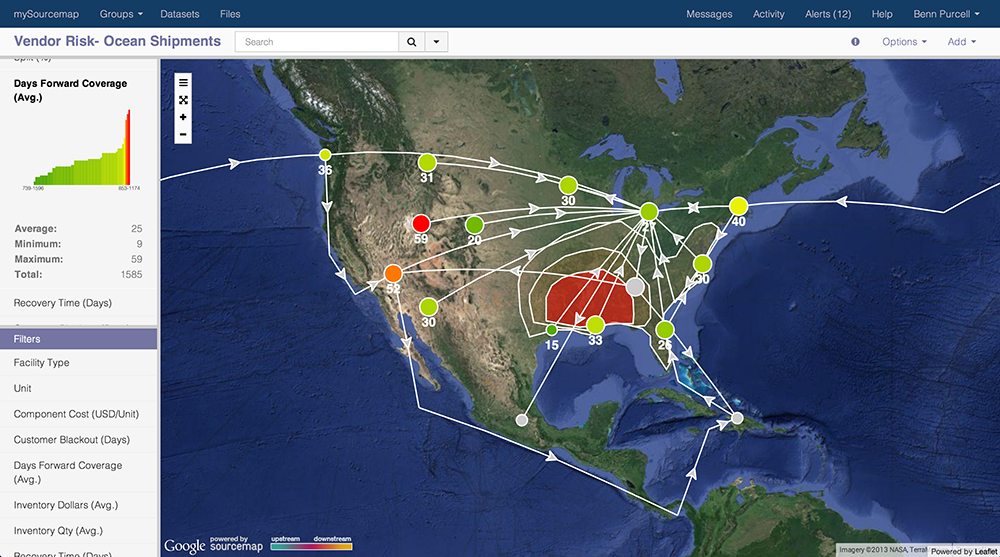
by Fronetics | Jul 30, 2015 | Blog, Marketing, Social Media

For decades, companies have relied on the recommendations of friends and family to acquire new customers and grow sales. Social media is now transforming how these recommendations are shared and given companies a way to directly interact with customers. With more than 1.9 billion monthly active users, Facebook is helping businesses amplify their marketing efforts in the places where their leads and prospects are spending their time. In fact, according to an annual report generated by the Content Marketing Institute and MarketingProfs, 84% of companies are using Facebook to distribute their content and promote their brand.
Today, Fronetics is announcing the addition of Facebook to its social media catalog. Click over and like Fronetics Strategic Advisors for up-to-date information on business strategy, marketing and sales, industry notes, blog content, and company announcements. Find Fronetics Strategic Advisors updates on Twitter, too. Follow @Fronetics. And find us on LinkedIn at https://www.linkedin.com/company/fronetics.
To celebrate the launch of our Facebook account, enjoy our top tips for using Facebook to market your business:
- Use the 80-20 rule. 80% of your posts should generate engagement – only 20% of your posts should be sales-focused
- Be sure to add a profile picture
- Use the “About” section to provide relevant company information
- Use photos and videos in posts – they’re likely to get the most views
- Don’t limit posts to only your business – share posts from partner businesses
- Experiment with different posting times to find what’s ideal for your target audience
- Respond to comments posted to your page
- Buy Facebook ads to capture attention
- Use a Call-To-Action button in the landing tab of your page
- Insert a Share Button on posts to encourage sharing of your content
Using Facebook is a great way to get found by visitors searching for your products or services. If you create a community that connects and engages with followers in meaningful ways, you’ll turn followers into leads and leads into customers.
Fronetics Strategic Advisors is a leading management consulting firm. Our firm works with companies to identify and execute strategies for growth and value creation.
Whether it is a wholesale food distributor seeking guidance on how to define and execute corporate strategy; a telematics firm needing high quality content on a consistent basis; a real estate firm looking for a marketing partner; or a supply chain firm in need of interim management, our clients rely on Fronetics to help them navigate through critical junctures, meet their toughest challenges, and take advantage of opportunities. We deliver high-impact results.
We advise and work with companies on their most critical issues and opportunities: strategy, marketing, organization, talent acquisition, performance management, and M&A support.
We have deep expertise and a proven track record in a broad range of industries including: supply chain, real estate, software, and logistics.


by Fronetics | Jul 29, 2015 | Blog, Content Marketing, Leadership, Marketing, Strategy

In an interview with the Kitchn, Food Network’s Barefoot Contessa Ina Garten shared her top three secrets to hosting a successful dinner party – plan ahead, use your best stuff, and have fun building and sustaining relationships with those around you. Her focus may be food, but her advice is applicable to marketing and sales professionals. Undeniably, lead nurturing is remarkably similar to hosting a dinner party.
Using the dinner party strategy, let’s take a look at how your business can actively build relationships with prospects and advance the movement of leads through its sales funnel.
Clean house
As the host of an upcoming dinner party, it’s unlikely you’d host people in your home without first getting it in tiptop shape. The same should be true for your website, your company’s online home. As part of your preparation for a lead nurturing campaign, review your website and make any necessary modifications so that it presents the best digital representation of your business. Beyond increasing conversions, having an attractive, modern website that’s free of broken links and out of date contact information serves to establish your company’s website as a trusted resource for information.
Decide what to offer guests
Preparing a dinner party menu for a number of people requires some forethought and planning. For instance, what type of food would your guests enjoy? Do any guests have food allergies or aversions for which you need to plan? Just as you would build the menu for your dinner party, the decision about what content you’ll offer will be guided by the preferences and content needs of your leads. Create content that is relevant to your leads and make sure to identify appropriate channels of distribution in order to extract maximum value from your content.
Determine when and how you’ll serve menu items
Traditional dinner parties start with appetizers and move from one course to the next until after the dessert wine is poured. Similarly, the lead nurturing process is intended to push content to leads in a linear fashion, with the ultimate goal being that they’ll emerge as customers. Once your content “menu” is set, you’ll want to decide how you’ll serve them up to your leads. To do that, align content with where your leads happen to be in the buyer’s journey. Leads will enter and exit your lead nurturing campaign at different points, and that’s okay, just be certain that your content is relevant to leads in their specific stage. Regardless, each nurturing touch should be focused and specific and include a call to action to promote advancement in the buyer’s journey.
Create and sustain dialogue
Beyond sharing a meal, it’s likely that you’ll also take part in spirited conversation with your dinner party guests. While it’s certainly acceptable to offer up topics of discussion, your guests will not enjoy you dominating the conversation. Meaningfully adding to the conversation builds relationships not just by showing expertise, but by showing genuine interest. In other words, don’t view the lead nurturing process as a way to blast your prospects with promotional information or marketing materials; treat it as a dialogue. The best lead nurturing campaigns are designed to learn as much about your leads as you would have them learn about your company.
Say thank you
As host, at the end of the night when guests grab their coats and head toward the door, it’s polite to thank them for attending your dinner party. Extend that same courtesy to your customers and leads. Whether it’s by showing gratitude to current customers for their continued support or showing appreciation to leads for their download, saying thank you goes a long way in building connections and professional relationships.
What’s required to run a successful lead nurturing campaign is building trust and establishing relationships with prospects and leads as you develop them into customers. Most of the effort involved in hosting a dinner party happens before guests arrive, so hosts are free to enjoy interaction and conversation with guests during the party. Lead nurturing can be approached much in the same way you’d plan and execute a dinner party. Developing a thoughtful lead nurturing campaign will almost always ensure meaningful – and memorable – communication.
Want to learn more about lead nurturing? Check out these 30 tricks and tips that will change the way you nurture leads.
Fronetics Strategic Advisors is a leading management consulting firm. Our firm works with companies to identify and execute strategies for growth and value creation.
Whether it is a wholesale food distributor seeking guidance on how to define and execute corporate strategy; a telematics firm needing high quality content on a consistent basis; a real estate firm looking for a marketing partner; or a supply chain firm in need of interim management, our clients rely on Fronetics to help them navigate through critical junctures, meet their toughest challenges, and take advantage of opportunities. We deliver high-impact results.
We advise and work with companies on their most critical issues and opportunities: strategy, marketing, organization, talent acquisition, performance management, and M&A support.
We have deep expertise and a proven track record in a broad range of industries including: supply chain, real estate, software, and logistics.


by Fronetics | Jul 28, 2015 | Blog, Leadership, Marketing, Strategy
 Only 1 in 10 professional marketers describe their lead nurturing efforts as “highly efficient and effective.” For most businesses, that’s simply not good enough. We’ve compiled the 30 greatest lead nurturing lessons into a guide. In it, you’ll learn the secrets of how top companies generate leads and nurture them into customers.
Only 1 in 10 professional marketers describe their lead nurturing efforts as “highly efficient and effective.” For most businesses, that’s simply not good enough. We’ve compiled the 30 greatest lead nurturing lessons into a guide. In it, you’ll learn the secrets of how top companies generate leads and nurture them into customers.
This guide will teach you:
- What makes killer performing landing pages
- The best lead-generating content
- How to create offers that are impossible to ignore
- Secret website optimization tips with A/B testing
- …and more!
This is your guide to start generating more high-quality sales leads today. Learn the tricks and tips you can use to nurture leads. Download it now.
Fronetics Strategic Advisors is a leading management consulting firm. Our firm works with companies to identify and execute strategies for growth and value creation.
Whether it is a wholesale food distributor seeking guidance on how to define and execute corporate strategy; a telematics firm needing high quality content on a consistent basis; a real estate firm looking for a marketing partner; or a supply chain firm in need of interim management, our clients rely on Fronetics to help them navigate through critical junctures, meet their toughest challenges, and take advantage of opportunities. We deliver high-impact results.
We advise and work with companies on their most critical issues and opportunities: strategy, marketing, organization, talent acquisition, performance management, and M&A support.
We have deep expertise and a proven track record in a broad range of industries including: supply chain, real estate, software, and logistics.


by Jennifer Hart Yim | Jul 27, 2015 | Blog, Marketing, Social Media, Supply Chain

Editor’s note: This is a guest post written by David Weaver. David has spent the past several years developing a best practice online marketing strategy for the inventory and supply chain division at INFORM GmbH.
Blogging has been around for years, yet some of the most basic questions regarding this communication method are still being asked. In fact, it has been around so long that some people are even asking the question “Is blogging dead?” My answer to that provocative question is of course no, but the blogging world is evolving. Despite the ever changing playing field, one of the most important success factors to blogging is to always keep the target audience in mind when writing an article. If content is not focused and targeted, a blog platform may actually experience a slow and agonizing death.
I started blogging in 2012, relatively late considering the concept has its roots in the 1990’s. Over the past three years, I have had the opportunity to network with some top bloggers as well as newcomers on the blogging scene. Whether I was the one asking or answering the questions, five common themes come up in the majority of blogging discussions I have been a part of. While the questions may be “basic” the answers, in my opinion, are not always easy:
-
What is the point?
This is a question I like to ask myself every time I write a new article. If I am not delivering either a fresh take on an existing topic or offering unique insights, I tend to rethink the purpose of the article. Regarding blogging in general, from a business perspective, numerous benefits can be realized:
- Expansion of online reach
- Lead generation
- Increased SEO presence
- Improved image
- Thought-Leadership
- Increased networking opportunities
-
Is it too late to start?
No. I recently attended a content marketing event, and next to “ephemeral media”, the topic of influencer marketing was heavily featured. The majority of attendees agreed that everyone is an influencer with a network of friends, family, colleagues and acquaintances. Blogging serves as outlet for the expression of this influence.
The good news is that there are a multitude of blogs already out there looking for contributors, so you don’t have to create something from scratch. As an example, if you are a supply chain professional wanting to share your experience on the topic of supplier relationship management, simply type in “supply chain blog” in Google and you will find several platforms that would be happy to hear from you.
-
How do I stay motivated/come up with ideas?
Next to actually starting to write, one of the most difficult tasks is writing a new article when the previous article you posted received little to no attention. This is often the case in the early stages of the blogging process and can be very discouraging. A discouraged writer will consequently have trouble in the idea development stage. Some ways to stay motivated and keep the creative juices flowing include:
- Brainstorming with family and friends
- Scanning Social Media for trending topics
- Asking readers and other industry experts for feedback
- Starting a blog series that will leave readers wanting more
- Varying your content and include videos, infographics and guest bloggers
If you are new to blogging, always keep in mind that the journey is long and developing a following/readership will take time. Don’t give up!
-
How often should I post?
The answer to this question is easy: it depends. There are differing opinions on this subject and the general rule of thumb is also vague, namely “post regularly.” My stance on the matter is that quality trumps quantity. If an article seems forced or does not bring something new to the table, it is best to allow the idea to mature and deliver a comprehensive article at a later date instead of posting to meet a deadline.
When starting out, it is best to set achievable goals i.e. “I will post one article per week.” On my first blog project, I set the goal of publishing an original article every Monday. This provided consistency for the readers and gave me time to develop new ideas.
-
How do I deal with critics?
I believe the fear of putting oneself out on the web is one of the highest hurdles to publishing articles on blog platforms. The fact is, there will be people that disagree with your opinion. The deciding factor is how you deal with the criticism. Getting into a name-calling, heated argument with an internet troll is not recommended and can only lead to a damaged reputation. With regard to constructive criticism and differing opinions, it is important to acknowledge the difference and remain professional. This includes respecting the other person’s opinions. In the end, it may be best to “agree to disagree”.
Closing thoughts
Aside from the purposes mentioned under “What is the point,” I use various blog platforms as a way to start a conversation and learn from others. Blogging is time consuming and hard work, but in my opinion, the benefits far outweigh the costs. My questions to you: If you are not blogging, why not? If you are blogging, what are some open questions you have?

by Fronetics | Jul 20, 2015 | Blog, Logistics, Marketing, Social Media, Strategy, Supply Chain

Sourcemap: doing well by doing good.
Leonardo Bonanni’s company, Sourcemap, is doing well by doing good, and he’s helping companies to do the same. In working on his doctoral thesis at MIT, Leonardo Bonanni created a service that is good for the world on many levels – it saves companies money and it works towards sustainability through transparency. Bonanni is bringing the people what they want. Consider these numbers from recent surveys:
- more than 88% of consumers think companies should try to achieve their business goals while improving society and the environment
- 83% of employees would seriously consider leaving their job if their employer used child labor in sweatshop factories
- 65% would seriously consider leaving their job if their company harmed the environment
Bonanni’s innovative company, Sourcemap, helps clients visually map the supply chain route, from raw materials to end-users, providing unique and important visibility. Companies like Stoneyfield, Mars Chocolate, Fairphone, and Office Depot can see risks and disruptions in the supply chain in real time, act responsibly, promote sustainability, and please consumers who are increasingly curious and conscientious about materials sourcing.
The likes of the Wall Street Journal, Forbes, and The Guardian have taken interest in Dr. Bonanni and Sourcemap. Here he shares some insights with Fronetics on the growth of the company and how he won’t rest until mapping the supply chain is status quo.
What’s the most exciting thing going on at Sourcemap right now?
2015 is the year of supply chain mapping. When we started helping companies trace their products to the source, it was 2007 and the question was ‘why would we want to do that?’ Today it’s ‘how fast can we start?’ Whether it’s risk, sustainability, or simply finding more efficient ways to source products, companies need a big picture of the end-to-end supply chain. What’s exciting is how fast and far we help our clients get there – sometimes in as little as one day.
Tell me about how the maps are built. Are the maps on the free source platform built the same way as the maps on the enterprise platform?
Sourcemap started as a service for consumers to find out where products come from (free.sourcemap.com is still the only website where anyone can make a supply chain map, no training required). Users log in and map a supply chain – from raw material to end customer – as easily as drawing dots and lines on a Google map. Soon after the free website launched manufacturers approached us to see if we could help them figure out where their products come from. We had a lot of experience from serving millions of visitors through our free website, so we knew how to make a robust and intuitive interface for supply chain mapping. We adapted the technology to enterprise needs by adding company specific KPI’s, network analytics, and real-time reporting. The difference is that our enterprise users don’t draw the supply chains one link at a time. Their maps are automatically generated in near-real time from transportation, purchasing, and product lifecycle management databases.
Is it hard to convince businesses that there is an economic or competitive advantage to a utilizing a platform like Sourcemap?
It’s true that Sourcemap was originally built for sustainability, and it can be hard for companies to dedicate resources to long-term issues when short-term priorities come up every day. But our first success wasn’t helping companies be more sustainable in the long term. It was helping them tackle short-term crises, by developing a supply chain repository for emergency response and business continuity planning. Our clients were spending days and weeks to determine how a natural or human-made disaster was impacting any of thousands of suppliers worldwide. We brought that time down to minutes. Then supply chain managers started to see the benefit of knowing not just who they buy from, but who their suppliers buy from – and making decisions to consolidate or diversify supply, move inventories around, and decide when to in-source / out-source processes. These decisions represent huge savings in overall supply chain cost.
This is fantastic tool for companies who are proud of their supply chains, but what about those companies who aren’t, or who aren’t even fully aware of the steps and impact of their chain?
Over the years we’ve worked with companies big and small, with widely differing visibility into their supply chains. What we’ve seen is that the biggest benefit – the low-hanging fruits – are there for first-time supply chain mappers. These are companies that have expanded through acquisitions, are entering new markets or introducing new products – basically any organization that needs to account for a whole new way of doing business. Then, supply chain mapping is the easiest way to keep tabs on everyone in the supply chain and make sure that decisions are taken with an eye on the big picture.
In the years you’ve been doing this work have you seen a shift in consumer demand around the sourcing of materials and making of products? Is there increasing social pressure for companies to “do good”?
We’ve seen two drivers for supply chain sustainability and transparency: companies who want to attract the best talent, and brands looking to differentiate their product by providing information on its price, its composition, or its source.
Given that you teach at Columbia, I’m wondering if you see a difference in the passion, awareness, and attitude around sustainability with younger generations? Have you seen growth in the enrollment numbers in your classes?
I like to teach one or two evening classes a year (this Fall at NYU) to see how supply chain thinking is evolving as it becomes more mainstream. My class hasn’t changed much since it started in 2007, but the students have. Sustainability used to be a futuristic concern, and no one outside logistics departments ever talked about supply chains. Today there is a real desire among students to be social entrepreneurs, and part of that means thinking about products and services holistically – making sure that the social and environmental impacts are drivers of innovation, not just a nice-to-have. Enrollment has grown, and so has the number of departments where supply chains play a role: from engineering, architecture and design to business, public policy and international affairs.
Has social media played a role in the growth of the business and/or the operations of the business?
Sourcemap wouldn’t be here without social media. The fact that our supply chain maps can be embedded in other websites attracted over a million visitors in the first year. We saw brands embedding maps of their supply chains on their own websites, and we got a tremendous amount of traffic from being embedded and linked from the Huffington Post, Wired and Fast Company.
What are your ultimate goals for Sourcemap?
Supply chain mapping – knowing where products originate – gets easier the more companies do it. It requires information sharing, which means tighter collaboration between buyers and sellers. We’ve seen it become a requirement of purchasing departments: if you want to sell your products, disclose the raw material origins. That makes it easier to trust – and verify – the quality, the compliance, the sustainability of the product. Personally, I won’t rest until supply chain mapping becomes part of doing business as usual.
Dr. Leonardo Bonanni is Founder and CEO of Sourcemap, the supply chain mapping company. The New York-based startup offers enterprise software for companies to trace products, evaluate social, environmental and financial risks, and monitor improvements over time. One day soon you’ll be able to scan a product on a store shelf and be connected to the people who made it through the Sourcemap social network.
Leo is a supply chain transparency advocate named among the 100 Most Influential People in Business Ethics (2011) and America’s Most Promising Social Entrepreneurs (2012). He teaches sustainability at Columbia and at MIT, where he received his doctorate from the MIT Media Lab. He has a background as an architect, an inventor and a performer.
Fronetics Strategic Advisors is a leading management consulting firm. Our firm works with companies to identify and execute strategies for growth and value creation.
Whether it is a wholesale food distributor seeking guidance on how to define and execute corporate strategy; a telematics firm needing high quality content on a consistent basis; a real estate firm looking for a marketing partner; or a supply chain firm in need of interim management, our clients rely on Fronetics to help them navigate through critical junctures, meet their toughest challenges, and take advantage of opportunities. We deliver high-impact results.
We advise and work with companies on their most critical issues and opportunities: strategy, marketing, organization, talent acquisition, performance management, and M&A support.
We have deep expertise and a proven track record in a broad range of industries including: supply chain, real estate, software, and logistics.


by Fronetics | Jul 9, 2015 | Blog, Data/Analytics, Marketing, Social Media
 In what seemed like a curious social experiment, KLM Royal Dutch Airline harnessed the popularity of social media and launched their “Meet and Seat” program in 2012. The service gives passengers the option to link their social media profiles to their boarding information during the ticket purchase process. Once a traveler’s profile is linked, they gain access to other social profiles of travelers that have also opted in to the service. Underling the concept is the notion that travelers will choose seatmates based on the profiles of users with similar business or leisure interests. While KLM reports that over 50,000 flyers have utilized the service since its inception – enough for KLM to deem the program successful – what’s discernable from KLM’s efforts is that social media has become a major player in today’s business world.
In what seemed like a curious social experiment, KLM Royal Dutch Airline harnessed the popularity of social media and launched their “Meet and Seat” program in 2012. The service gives passengers the option to link their social media profiles to their boarding information during the ticket purchase process. Once a traveler’s profile is linked, they gain access to other social profiles of travelers that have also opted in to the service. Underling the concept is the notion that travelers will choose seatmates based on the profiles of users with similar business or leisure interests. While KLM reports that over 50,000 flyers have utilized the service since its inception – enough for KLM to deem the program successful – what’s discernable from KLM’s efforts is that social media has become a major player in today’s business world.
With a reported 8 out of 10 businesses using social media in the communication between their brand and their audiences, companies are spending more marketing dollars on social efforts with increasing regularity. But with its fairly recent introduction to the business world, many companies are struggling to determine whether their efforts, and their investments, are paying off. Fortunately, by focusing on a few key metrics, your company can start to understand which of your social efforts are adding value and, just as important, which ones are not.
Here are the 4 social metrics that matter:
Source Reports
The most common remark about measurement you’ll hear social media marketing experts say is that social media efforts shouldn’t be solely measured in likes and follows. It’s hard to connect the number of likes and follows to financial business metrics, so thinking about the success of your channels in different terms gives a more insightful report about how your social channels are performing. HubSpot recommends tracking the network source of your web traffic, leads, and customers to determine how your social platforms are performing.
Track: # of visits, leads, and customers for each of your social channels
Engagement and Amplification
“No man is an island,” wrote John Donne in his poem. His summation about the nature of humans is quite evident in social media. Indeed, one of the greatest benefits of social media is that it is by its very nature, social. For companies, social media exponentially expands the reach of its content by playing on the communal nature of these networks. If a company has 2,000 followers on Twitter, and each of them shared that company’s content with 200 of their followers, the amplification of its content has expanded to 200,000 users. Your business can leverage these immense networks by maintaining consistency in the quality and value of your content as this strategy will naturally inspire followers to share and repost your content. Track the types of content that drives the most amplification and identify trends in popular publishing times, then refine your efforts based on your analysis. Remember, as a business using social media, your end goal is action, not eyes. In other words, what’s important to your efforts is engagement. Pay close attention to how your followers are interacting with your content.
Track: # of Facebook Post Shares, # of Retweets, # of Twitter Mentions
Lead Generation
Put simply, lead generation activity lets you know whether your social content is generating leads and creating opportunities for your business. At the end of the day, your social efforts don’t matter if they aren’t playing a part in driving new business. Of particular value to your business is your conversion rate. Knowing how often content consumption results in a new lead will help you to build a more successful overall content strategy. Is your new infographic converting visitors to leads at a higher rate than your verbose Facebook posts? That might be a sign that your audience responds better to image-heavy content.
Track: # of form submissions, # of email subscribers, conversion rate
Return on Investment
If one of your company’s objectives for its social media participation is to drive growth, your company’s ROI calculation is one of the most important measurements of your social efforts. This measurement determines what impact your social content is having on customer acquisition and sales. Just as you would for all other marketing efforts, you need to know whether or not the investment you’re making in social media is producing a positive return for your business. To find your investment, start by calculating the total of your investment, your overhead factor, and your miscellaneous costs. To calculate your return, you’ll need to know your leads per month, your lead conversion rate, your average lifetime customer value, and average profit margin. Let’s take a look at how those factor into your ROI calculation in the example below.
To Calculate Investment
- Multiply the hours per month needed to create the content by the hourly rate of the employees used to create the content.
- Multiply the result by the overhead factor, taking into account rent, insurance, utilities, etc. (typically 50%)
- Add all other costs, such as design fees, hosting fees, subscriptions, software, etc. You may choose to allocate them to a specific piece of content or amortize them monthly and spread the costs evenly across each piece of content.
Calculation: At 40 hours/month at $40/hour to produce a corporate blog, multiplied by a 50% overhead factor. Add in $1k/month for design, $100/month for hosting, and $100/month for miscellaneous fees.
Total Investment in Monthly Blog = $3,600
To Calculate Return
Multiply your leads per month by your lead conversion rate, average lifetime customer value, and average profit margin.
Calculation: You collect 25 leads a month from your blog. At a 20% lead conversion rate, you’ll generate five new customers. Assume a $3,000 average lifetime customer value and a 30% average profit margin.
Total Monthly Blogging Return = $4,500
To Calculate Return on Investment
Subtract the investment from the return. Then, divide by the investment.
Calculation:
$4,500 – $3,600 = 900
900/3,600 = .25
ROI = 25%
Nearly 70% of communications professionals report dissatisfaction in how they’re measuring their social efforts. That’s understandable, social can be cumbersome to analyze. But looking at activity through the lens of your business objectives should really get to the heart of why your company participates in social media. In your work to distinguish your company from the thousands of others in the sea of social, seek to create rich and robust social experiences for your followers by connecting them with relevant and valuable content. Then measure that user activity and engagement to see how it is helping grow your business.
Fronetics Strategic Advisors is a leading management consulting firm. Our firm works with companies to identify and execute strategies for growth and value creation.
Whether it is a wholesale food distributor seeking guidance on how to define and execute corporate strategy; a telematics firm needing high quality content on a consistent basis; a real estate firm looking for a marketing partner; or a supply chain firm in need of interim management, our clients rely on Fronetics to help them navigate through critical junctures, meet their toughest challenges, and take advantage of opportunities. We deliver high-impact results.
We advise and work with companies on their most critical issues and opportunities: strategy, marketing, organization, talent acquisition, performance management, and M&A support.
We have deep expertise and a proven track record in a broad range of industries including: supply chain, real estate, software, and logistics.










